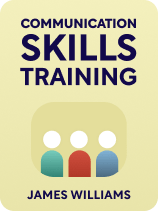
How often do you misunderstand what people are saying? When someone’s talking to you, do you pay attention to more than just the words they say?
Every day, you hear people communicate. But, hearing doesn’t necessarily equal understanding. To completely get what someone is attempting to communicate to you takes skill—specifically, the skill of active listening.
Read more to learn how to practice active listening and stop missing what people are trying to tell you.
How to Practice Active Listening
In Communication Skills Training, James Williams identifies active listening as a core communication skill. He explains what it is and provides advice on how to practice active listening.
Williams explains that, to communicate effectively, you must fully understand the other person—not just the content of their statement, but the emotions and intent behind it. To form this understanding, you must actively listen. Pay attention not just to what they say, but how they say it—their tone, word choice, body language, and so on. If you don’t, you might misunderstand the other person—or miss their main point—and therefore respond inappropriately.
For example, your friend might be telling you about their son’s soccer game and an encounter they had with a mean person there. Their eyebrows knit and their tone sounds dejected—their intent was to express their hurt feelings from the encounter. However, you respond by asking who won the soccer game because you weren’t paying attention to the smaller details that indicated which part of the person’s story was most important.
(Shortform note: Some other experts reiterate the importance of active listening to fully understanding communication, and they add that this practice has many benefits beyond aiding an effective response. For example, listening actively can demonstrate the desirable workplace skill of patience, which can help progress your career. Further, it makes other people feel supported, which will help you develop relationships and make new friends.)
Williams provides four main tips for practicing active listening.
Tip #1: Prepare to Receive the Other Person’s Message
To prepare to receive the other person’s message, Williams makes three main recommendations. First, make eye contact. Second, fully concentrate on the other person. Third, keep an open mind so you can receive their message without making judgments.
(Shortform note: To effectively follow Williams’s advice here, it may help to first develop an empathetic mindset. In 4 Essential Keys to Effective Communication, Bento C. Leal explains that this involves believing everyone deserves empathy due to their inherent worthiness and uniqueness. This will create a genuine internal desire to listen to and understand the other person without judgment. To develop an empathetic perspective, you must first develop strong self-worth—view yourself as unique and worthy of empathy and understanding. Once you’ve developed this inner perspective, you can turn it outwards and view others as equally unique and worthy.)
Tip #2: Receive Their Message
To effectively receive someone’s message, Williams says you must continue to focus entirely on the other person. Listen to what they say and don’t say, and try to pick up on their emotions by paying attention to their tone, facial expressions, body movements, and so on. Avoid thinking about your response to their message or making judgments on what they’ve said—you can’t listen and reflect at the same time. Further, show the other person you’re listening by nodding along or giving vocal affirmations like “mhm.”
Tip #3: Prepare to Respond
Williams says to make sure the other person is completely finished speaking before you formulate your response. Plan to match your emotions to theirs—this will help you respond appropriately. For instance, if they seem sad and muted, avoid being inappropriately exuberant and joyful. Further, make sure you respond to the main point they’re making rather than the unimportant details.
| Improving Communication For People With ADHD and Autistic People Attaining a high level of focus on another person, silencing your own thoughts, and reading and matching others’ body language and emotions can be difficult—especially for people with ADHD or autistic people. People with ADHD often experience disruptive thoughts and struggle to focus on one thing at a time. This can also make it more difficult to determine and respond to someone’s main point. Autistic people may struggle to interpret body language or effectively interpret and express emotions. (Autistic people can also struggle to make eye contact with others, as Williams recommended doing in Tip #1.) People in these situations may need to take extra steps to effectively follow Williams’s advice. For example, those with ADHD can improve their ability to stay focused on and engaged with others by taking notes on what their conversation partner is saying or asking them to clearly state their main points. Autistic people can improve their ability to interpret and use body language and emotions through practice—for example, by watching videos online of people expressing certain emotions and trying to mimic that body language in front of a mirror. |
Tip #4: Respond Effectively
When you respond, Williams recommends showing the other person you understand them by sharing your interpretation of what they said, explained in your own words. Further, avoid responses that might indicate you’re uninterested in listening to them or want to make things about yourself—for instance, offering advice, pity, corrections, comfort, or personal stories, or trying to one-up them.
(Shortform note: In Nonviolent Communication, Marshall B. Rosenberg also warns against these specific poor responses and notes four additional responses you must avoid to communicate effectively: excuses, interrogations, turning the situation into a learning lesson, and shutting someone down with statements like, “Don’t worry, you’ll feel better soon.” Further, he recommends effectively paraphrasing the person’s statement by asking questions that address their possible feelings and needs. This allows the other person to clarify if needed and prevent misunderstandings. For example, you might ask, “Are you feeling angry with me because you needed help and I wasn’t there?”)

———End of Preview———
Like what you just read? Read the rest of the world's best book summary and analysis of James Williams's "Communication Skills Training" at Shortform.
Here's what you'll find in our full Communication Skills Training summary:
- Why effective communication is one of the most important skills to have
- How to develop your communication skills through intentional practice
- Why emotional control is central to expressing yourself effectively






